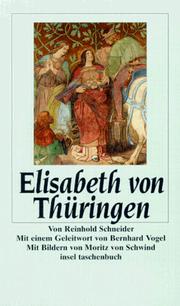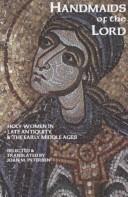| Listing 1 - 10 of 18 | << page >> |
Sort by
|

ISBN: 9783458338185 3458338187 Year: 1997 Publisher: Frankfurt am Main: Insel,
Abstract | Keywords | Export | Availability | Bookmark
 Loading...
Loading...Choose an application
- Reference Manager
- EndNote
- RefWorks (Direct export to RefWorks)
Book
ISBN: 0884022412 9780884022411 Year: 1996 Volume: 1 Publisher: Washington: Dumbarton Oaks center for Byzantine studies,
Abstract | Keywords | Export | Availability | Bookmark
 Loading...
Loading...Choose an application
- Reference Manager
- EndNote
- RefWorks (Direct export to RefWorks)
Christian women saints --- Saintes chrétiennes --- Biography --- Biographie --- Byzantine Empire --- Empire byzantin --- Church history --- Histoire religieuse --- 235.3-055.2 --- 235.3 <495 BYZANTIUM> --- -Christian saints, Women --- Women Christian saints --- Christian saints --- Women saints --- Heilige vrouwen --- Hagiografie--Griekenland--BYZANTIUM --- -Church history --- Biography. --- 235.3-055.2 Heilige vrouwen --- -Heilige vrouwen --- -235.3-055.2 Heilige vrouwen --- Christian saints, Women --- Saintes chrétiennes --- Church history. --- Christian women saints - Byzantine Empire - Biography --- Marina v. dicta Marinus mon. --- Maria Aegyptiaca --- Theoctista Lesbia in insula Paro --- Elisabeth thaumaturga --- Athanasia, heg. in Aegina insula --- Theodora Thessalonicensis --- Maria iunior matrona Bizyae in Thracia --- Thomaïs Lesbia --- Theodora regina Epiri (mart. 11)
Book
ISBN: 3761301782 9783761301784 Year: 1994 Volume: 43 Publisher: Würzburg: Augustinus,
Abstract | Keywords | Export | Availability | Bookmark
 Loading...
Loading...Choose an application
- Reference Manager
- EndNote
- RefWorks (Direct export to RefWorks)
Christian women saints --- Christian hagiography --- History --- 235.3-055.2 --- -Christian women saints --- -Hagiography --- Hagiology --- Saints --- Christian saints, Women --- Women Christian saints --- Christian saints --- Women saints --- Heilige vrouwen --- 235.3-055.2 Heilige vrouwen --- Christian women saints - Palestine --- Christian women saints - Georgia (Republic) --- Christian women saints - Armenia --- Christian women saints - Byzantine Empire --- Christian hagiography - History - To 1500

ISBN: 0879077433 0879075430 9780879075439 9780879077433 Year: 1996 Publisher: Kalamazoo Cistercian publ.
Abstract | Keywords | Export | Availability | Bookmark
 Loading...
Loading...Choose an application
- Reference Manager
- EndNote
- RefWorks (Direct export to RefWorks)
235.3-055.2 --- 235.3-055.2 Heilige vrouwen --- Heilige vrouwen --- Asceticism --- Ascetics --- Ascetics. --- Ascétisme --- Asketin. --- Femmes dans le christianisme --- Godgewijde maagden. --- Women in Christianity --- Early church. --- History --- Histoire --- 30-600. --- Kirchengeschichte 50-600. --- Christianity --- Persons --- Early works to 1800 --- History&delete& --- Sources
Book
ISBN: 9788843072958 8843072951 Year: 2017 Volume: 241 Publisher: Roma: Carocci,
Abstract | Keywords | Export | Availability | Bookmark
 Loading...
Loading...Choose an application
- Reference Manager
- EndNote
- RefWorks (Direct export to RefWorks)
225-055.2 --- 235.3-055.2 --- 235.3-055.2 Heilige vrouwen --- Heilige vrouwen --- 225-055.2 Vrouwen in het Nieuwe Testament --- Vrouwen in het Nieuwe Testament --- Mary Magdalene, --- Maddalena, --- Madeleine, --- Magdaghinē, --- Magdalene, --- Maria Maddalena, --- Maria Magdalena, --- Mariam Magdaghenatsʻi, --- Marie Madeleine, --- Mary Magdalen, --- Maryam al-Majdalīyah, --- Maria Magdalena --- Mary Magdalene, - Saint --- Mary Magdalene, - Saint - Art
Book
ISSN: 12424706 0768021X ISBN: 285589378X 9782855893785 Year: 2001 Volume: 78 Publisher: Bégrolles-en-Mauges: Abbaye de Bellefontaine,
Abstract | Keywords | Export | Availability | Bookmark
 Loading...
Loading...Choose an application
- Reference Manager
- EndNote
- RefWorks (Direct export to RefWorks)
Women in Christianity --- Monastic and religious life of women --- History --- 235.3-055.2 --- 396.7 --- 396.7 Vrouw en religie --- Vrouw en religie --- 235.3-055.2 Heilige vrouwen --- Heilige vrouwen --- Women in Christianity - History - Early church, ca. 30-600. --- Monastic and religious life of women - History - Early church, ca. 30-600.
Book
ISBN: 9782204139816 2204139815 Year: 2020 Volume: 610 Publisher: Paris: Cerf,
Abstract | Keywords | Export | Availability | Bookmark
 Loading...
Loading...Choose an application
- Reference Manager
- EndNote
- RefWorks (Direct export to RefWorks)
Geneviève, au début du Ve siècle, choisit de consacrer sa vie à Dieu : encouragée par l’évêque Germain d’Auxerre, elle mène une vie de prière et de charité au moment où les rois francs prennent le pouvoir en Gaule du Nord. Geneviève s’intéresse à tout ce qui touche ses contemporains : les angoisses de la guerre, les difficultés du ravitaillement, les raids hunniques, mais aussi les fièvres du nourrisson et la pluie qui gêne la moisson ; elle soulage tous les maux d’autrui par sa puissante intercession. La vie de cette femme paraît à ceux qui l’ont connue un tel modèle de foi et d’ascèse qu’un premier biographe la met par écrit dans les vingt ans qui suivent sa mort : Geneviève a désormais une Vie qui proclame sa sainteté, puis une deuxième, destinée aux cercles aristocratiques francs (VIe s. ?), puis une troisième, pour rappeler aux temps carolingiens qui fut la sainte mérovingienne… Chaque nouvelle Vie de Geneviève est à la fois un témoignage sur une croyante et une source sur la société médiévale qui raconte son histoire.
Genevieve of Paris --- Geneviève, --- Christian women saints --- Geneviève, --- 235.3 GENOVEVA --- 235.3-055.2 --- 235.3-055.2 Heilige vrouwen --- Heilige vrouwen --- 235.3 GENOVEVA Hagiografie--GENOVEVA --- 235.3 GENOVEVA Hagiographie--GENOVEVA --- Hagiografie--GENOVEVA --- Hagiographie--GENOVEVA --- Genofeva, --- Theologische teksten (Middeleeuwen) --- Geneviève --- Genovefa v. Parisiensis --- Geneviève
Book
ISBN: 9782503589985 2503589987 Year: 2020 Volume: 306 Publisher: Turnhout: Brepols,
Abstract | Keywords | Export | Availability | Bookmark
 Loading...
Loading...Choose an application
- Reference Manager
- EndNote
- RefWorks (Direct export to RefWorks)
Le poche notizie che si hanno sulla vita e i miracoli di Rosa da Viterbo, la fanciulla nata attorno al 1233 e morta nel 1251 o 1252, che diede testimonianze della sua fede al tempo di Federico II, sono note da tempo. Tutti coloro che hanno scritto di Rosa da Viterbo hanno attinto, direttamente o più spesso indirettamente, dal verbale del processo di canonizzazione svoltosi a Viterbo al tempo di papa Callisto III, a distanza di due secoli e poco più dalla morte della beata. Questa fonte però non è conosciuta in maniera scientifica. Gli atti del processo di canonizzazione del 1457 non sono mai stati pubblicati. La Vita che vi è contenuta fu pubblicata (piuttosto malamente) per la prima volta nel 1742 dal canonico viterbese Feliciano Bussi nella sua Istoria della Città di Viterbo. Migliore, naturalmente, ma perfettibile è l'edizione che della Vita e dei Miracula fecero nel 1868 i padri Bollandisti nei loro Acta Sanctorum. Nel 1952 pubblicò ottimamente la Vita Giuseppe Abate. Infine, la Vita e i Miracula di Rosa hanno fatto oggetto del primo anno di attività (2016-2017) del Laboratorio di agiografia (sottotitolo: Filologia, edizione, interpretazione delle fonti) aggregato alla Scuola superiore di studi medievali e francescani della Pontificia Università Antonianum, ed è stato pubblicato un volume che riproduce il lavoro seminariale. Della Vita e dei miracoli di Rosa si hanno, però, altri due altri testimoni, uno conservato a Parigi e uno a Parma, certamente legati al processo. Questa edizione si basa per la prima volta sul trattamento contestuale di tutti i prodotti documentari e librari ad oggi connessi all'iniziativa del 1456-57.
Rose of Viterbo --- Christian women saints --- Miracles --- Saintes chrétiennes --- Hagiographie chrétienne. --- Rose, --- 235.3 ROSA --- 235.3-055.2 --- 235.3-055.2 Heilige vrouwen --- Heilige vrouwen --- 235.3 ROSA Hagiografie--ROSA --- 235.3 ROSA Hagiographie--ROSA --- Hagiografie--ROSA --- Hagiographie--ROSA --- Rosa, --- Rosa of Viterbo, --- Rosalia, --- Venerini, Rosa, --- Viterbo, Rose of, --- Vita et miracula Rosae de Viterbio --- Rosa v. Viterbiensis
Book
ISBN: 2873650044 9782873650049 Year: 1992 Volume: 76 Publisher: Bruxelles: Société des Bollandistes,
Abstract | Keywords | Export | Availability | Bookmark
 Loading...
Loading...Choose an application
- Reference Manager
- EndNote
- RefWorks (Direct export to RefWorks)
Christian church history --- anno 500-1499 --- Histoire ecclésiastique --- Kerkgeschiedenis --- Biography --- Christian saints --- Christian women saints --- Queens --- Biographie --- Saints chrétiens --- Saintes chrétiennes --- Reines --- Cult --- History of doctrines --- Culte --- Histoire des doctrines --- Biographies --- 235.3-055.2 --- -Queens --- -Biography --- -Christian saints --- -Saints --- Canonization --- History --- Life histories --- Memoirs --- Auxiliary sciences of history --- Genealogy --- Royalty --- Rulers --- Sovereigns --- Monarchy --- Women --- Courts and courtiers --- Empresses --- Kings and rulers --- Christian saints, Women --- Women Christian saints --- Women saints --- Heilige vrouwen --- -History of doctrines --- -Congresses --- Biography. --- -Heilige vrouwen --- 235.3-055.2 Heilige vrouwen --- -235.3-055.2 Heilige vrouwen --- Saints chrétiens --- Saintes chrétiennes --- Biography, Medieval --- Medieval biography --- Middle Ages --- Christian saints - Cult - History of doctrines - Middle Ages, 600-1500. --- Christian women saints - Biography. --- Biography - Middle Ages, 500-1500. --- Queens - Biography. --- Christian women saints - Cult - History of doctrines - Middle Ages, 600-1500.
Book
ISBN: 9780268108540 0268108544 9780268108533 9780268108564 9780268108557 0268108552 0268108560 0268108536 Year: 2020 Publisher: Notre Dame, Indiana : University of Notre Dame Press,
Abstract | Keywords | Export | Availability | Bookmark
 Loading...
Loading...Choose an application
- Reference Manager
- EndNote
- RefWorks (Direct export to RefWorks)
In Fifteenth-Century Lives, Karen A. Winstead identifies and explores a major shift in the writing of Middle English saints' lives. As she demonstrates, starting in the 1410s and '20s, hagiography became more character-oriented, more morally complex, more deeply embedded in history, and more politically and socially engaged. Further, it became more self-consciously literary and began to feature women more prominently--and not only traditional virgin martyrs but also matrons and contemporary holy women. Winstead shows that this literature placed a premium on scholarship and teaching. Hagiography celebrated educators and scholars more than ever before and became a vehicle for educating readers about Christian dogma. Focusing both on authors well known, such as John Lydgate and Margery Kempe, and on others less known, such as Osbern Bokenham and John Capgrave, Winstead argues that the values promoted by fifteenth-century hagiography helped to shape the reformist impulses that eventually produced the Reformation. Moreover, these values continued to influence post-Reformation hagiography, both Protestant and Catholic, well into the seventeenth century.
235.3 "04/14" --- 235.3 <420> --- 235.3-055.2 --- 235.3-055.2 Heilige vrouwen --- Heilige vrouwen --- 235.3 <420> Hagiografie--Engeland --- 235.3 <420> Hagiographie--Engeland --- Hagiografie--Engeland --- Hagiographie--Engeland --- 235.3 "04/14" Hagiografie--Middeleeuwen --- 235.3 "04/14" Hagiographie--Middeleeuwen --- Hagiografie--Middeleeuwen --- Hagiographie--Middeleeuwen --- Christian hagiography. --- Christian saints --- Christian women saints --- Historiography --- Historiography. --- History --- 1066-1499. --- England --- England. --- Church history --- 1066-1499
| Listing 1 - 10 of 18 | << page >> |
Sort by
|

 Search
Search Feedback
Feedback About UniCat
About UniCat  Help
Help News
News